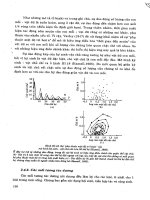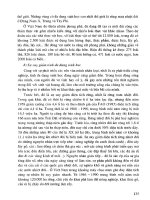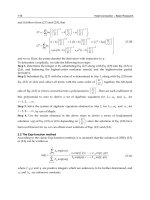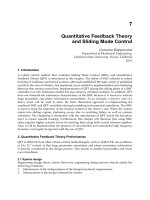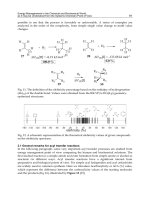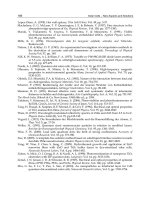Manufacturing the Future 2012 Part 6 potx
Bạn đang xem bản rút gọn của tài liệu. Xem và tải ngay bản đầy đủ của tài liệu tại đây (5.29 MB, 50 trang )
Application Similarity Coefficient Method To Cellular Manufacturing 241
condition of different RE ratios. All similarity coefficients perform best under a
low RE ratio (data sets are well-structured). Only a few of similarity coeffi-
cients perform well under a high RE ratio (data sets are ill-structured), Sokal &
Sneath 2 is very good for all RE ratios. Again, the four similarity coefficients:
Hamann, Simple matching, Rogers & Tanimoto, and Sokal & Sneath, perform
badly under high RE ratios.
REC RE
Litera-
ture
All ran-
dom
0.7 0.8 0.9
0.05-
0.15
0.2-0.3
0.35-
0.4
No
.
Similarity Coef-
ficient
D S D S D S D S D S D S D S D S
1 Jaccard 5 6 6 9 8 9 8 9 9 9 9 9 9 9 8 9
2 Hamann 0 0 2 1 1 1 2 3 7 7 9 9 1 0 2 2
3 Yule 4 4 2 6 3 7 5 7 7 8 9 9 2 6 6 7
4 Simple matching 0 0 2 0 1 0 3 5 6 8 9 9 0 0 2 2
5 Sorenson 6 4 9 8 7 9 8 9 9 9 9 9 9 9 7 7
6
Rogers & Tani-
moto 0 0 2 1 2 2 4 4 6 7 9 9 1 2 2 2
7 Sokal & Sneath 0 0 0 0 2 1 5 6 6 8 9 9 1 1 2 2
8 Rusell & Rao 4 4 5 3 5 5 9 8 8 6 9 9 9 8 6 6
9
Baoroni-Urban &
Buser 5 6 1 3 3 7 9 7 7 8 9 9 4 7 2 6
10 Phi 5 5 6 6 9 7 8 8 7 8 9 9 9 8 7 7
11 Ochiai 1 4 8 7 9 7 8 8 9 9 9 9 9 9 7 7
12 PSC 2 2 9 8 9 9 9 8 9 9 9 9 9 9 8 9
13 Dot-product 3 5 9 8 7 9 8 9 9 9 9 9 9 9 7 7
14 Kulczynski 2 5 8 7 8 8 8 8 9 9 9 9 9 9 7 7
15 Sokal & Sneath 2 4 5 6 8 9 9 7 9 9 9 9 9 9 9 9 9
16 Sokal & Sneath 4 5 5 7 6 8 7 8 8 7 8 9 9 8 8 7 7
17
Relative match-
ing
5 4 4 8 7 9 9 9 9 9 9 9 5 9 6 8
18
Chandraseharan
& Rajagopalan 2 5 8 6 9 8 8 8 7 7 9 9 9 9 6 7
19 MaxSC 1 4 8 6 9 8 8 8 7 7 9 9 9 9 6 7
20
Baker & Maro-
poulos
5 3 6 9 7 9 8 9 9 9 9 9 6 9 6 8
Table 14. Comparative results under various conditions. D: discriminability; S: stabil-
ity
Manufacturing the Future: Concepts, Technologies & Visions
242
Figure 6. Performance for all tested problems
Application Similarity Coefficient Method To Cellular Manufacturing 243
Figure 7. Performance under different REC
Manufacturing the Future: Concepts, Technologies & Visions
244
Figure 8. Performance under different RE
Application Similarity Coefficient Method To Cellular Manufacturing 245
In summary, three similarity coefficients: Jaccard, Sorenson, and Sokal &
Sneath 2 perform best among twenty tested similarity coefficients. Jaccard
emerges from the twenty similarity coefficients for its stability. For all prob-
lems, from literature or deliberately generated; and for all levels of both REC
and RE ratios, Jaccard similarity coefficient is constantly the most stable coeffi-
cient among all twenty similarity coefficients. Another finding in this study is
four similarity coefficients: Hamann, Simple matching, Rogers & Tanimoto,
and Sokal & Sneath are inefficient under all conditions. So, these similarity co-
efficients are not recommendable for using in cell formation applications.
9. Conclusions
In this paper various similarity coefficients to the cell formation problem were
investigated and reviewed. Previous review studies were discussed and the
need for this review was identified. The reason why the similarity coefficient
based methods (SCM) is more flexible than other cell formation methods were
explained through a simple example. We also proposed a taxonomy which is
combined by two distinct dimensions. The first dimension is the general-
purpose similarity coefficients and the second is the problem-oriented similar-
ity coefficients. The difference between two dimensions is discussed through
three similarity coefficients. Based on the framework of the proposed taxon-
omy, existing similarity (dissimilarity) coefficients developed so far were re-
viewed and mapped onto the taxonomy. The details of each production infor-
mation based similarity coefficient were simply discussed and a evolutionary
timeline was drawn based on reviewed similarity coefficients. Although a
number of similarity coefficients have been proposed, very fewer comparative
studies have been done to evaluate the performance of various similarity coef-
ficients. This paper evaluated the performance of twenty well-known similar-
ity coefficients. 94 problems from literature and 120 problems generated delib-
erately were solved by using the twenty similarity coefficients. To control the
generation process of data sets, experimental factors have been discussed. Two
experimental factors were proposed and used for generating experimental
problems. Nine performance measures were used to judge the solutions of the
tested problems. The numerical results showed that three similarity coeffi-
cients are more efficient and four similarity coefficients are inefficient for solv-
ing the cell formation problems. Another finding is that Jaccard similarity coef-
ficient is the most stable similarity coefficient. For the further studies, we
Manufacturing the Future: Concepts, Technologies & Visions
246
suggest comparative studies in consideration of some production factors, such
as production volumes, operation sequences, etc. of parts.
7. References
Agarwal, A., Sarkis, J., 1998. A review and analysis of comparative performance
studies on functional and cellular manufacturing layouts. Computers and
Industrial Engineering 34, 77-89.
Akturk, M.S., Balkose, H.O., 1996. Part-machine grouping using a multi-objective
cluster analysis. International Journal of Production Research 34, 2299-2315.
Al-Sultan, K.S., Fedjki, C.A., 1997. A genetic algorithm for the part family forma-
tion problem. Production Planning & Control 8, 788-796.
Anderberg, M.R., 1973. Cluster analysis for applications (New York: Academic
Press).
Arthanari, T.S., Dodge, Y., 1981. Mathematical programming in statistics (New
York: John Wiley & Sons, Inc).
Askin, R.G., Cresswell, S.H., Goldberg, J.B., Vakharia, A.J., 1991. A Hamiltonian
path approach to reordering the part-machine matrix for cellular manufac-
turing. International Journal of Production Research 29, 1081-1100.
Askin, R.G., Selim, H.M., Vakharia, A.J., 1997. A methodology for designing flexi-
ble cellular manufacturing systems. IIE Transaction 29, 599-610.
Askin, R.G., & Subramanian, S.P., 1987. A cost-based heuristic for group technol-
ogy configuration. International Journal of Production Research, 25(1), 101-113.
Askin, R.G., Zhou, M., 1998. Formation of independent flow-line cells based on
operation requirements and machine capabilities. IIE Transactions 30, 319-
329.
Baker, R.P., Maropoulos, P.G., 1997. An automatic clustering algorithm suitable for
use by a computer-based tool for the design, management and continuous
improvement of cellular manufacturing systems. Computers Integrated
Manufacturing Systems 10, 217-230.
Balakrishnan, J., 1996. Manufacturing cell formation using similarity coefficients
and pair-wise interchange: formation and comparison. Production Planning
& Control 7, 11-21.
Balakrishnan, J., Cheng, C. H., 1998. Dynamic layout algorithms: a state-of-the-art
survey. Omega 26, 507-521.
Balakrishnan, J., Jog, P.D., 1995. Manufacturing cell formation using similarity co-
efficients and a parallel genetic TSP algorithm: formulation and comparison.
Mathematical and Computer Modelling 21, 61-73.
Application Similarity Coefficient Method To Cellular Manufacturing 247
Balasubramanian, K.N., Panneerselvam, R., 1993. Covering technique-based algo-
rithm for machine grouping to form manufacturing cells. International Jour-
nal of Production Research 31, 1479-1504.
Baroni-Urbani, C., Buser, M.W., 1976. Similarity of binary data. Systematic Zool-
ogy 25, 251-259.
Baykasoglu, A., Gindy, N.N.Z., 2000. MOCACEF 1.0: multiple objective capability
based approach to form part-machine groups for cellular manufacturing ap-
plications. International Journal of Production Research 38, 1133-1161.
Beatty, C.A., 1992. Implementing advanced manufacturing technologies: rules of
the road. Sloan Management Review Summer, 49-60.
Ben-Arieh, D., Chang, P.T., 1994. An extension to the p-median group technology
algorithm. Computers and Operations Research 21, 119-125.
Ben-Arieh, D., Sreenivasan, R., 1999. Information analysis in a distributed dy-
namic group technology method. International Journal of Production Eco-
nomics 60-61, 427-432.
Bijnen, E.J., 1973. Cluster analysis (The Netherlands: Tilburg University Press).
Bishop, Y.M.M., Fienberg, S.E., Holland, P.W., 1975. Discrete multivariate analysis:
theory and practice (MA: MIT Press Cambridge).
Boctor, F.F., 1991. A linear formulation of the machine-part cell formation problem.
International Journal of Production Research, 29(2), 343-356.
Boe, W.J., & Cheng, C.H., 1991. A close neighbour algorithm for designing cellular
manufacturing systems. International Journal of Production Research, 29(10),
2097-2116.
Burbidge, J.L., 1971. Production flow analysis. Production Engineer 50, 139-152.
Burbidge, J.L., Falster, P., Rhs, J.O., 1991. Why is it difficult to sell group technol-
ogy and just-in-time to industry? Production Planning & Control 2, 160-166.
Carrie, A.S., 1973. Numerical taxonomy applied to group technology and plant
layout. International Journal of Production Research 11, 399-416.
Cedeno, A.A., Suer, G.A., 1997. The use of a similarity coefficient-based method to
perform clustering analysis to a large set of data with dissimilar parts. Com-
puters and Industrial Engineering 33, 225-228.
Chan, H.M., & Milner, D.A., 1982. Direct clustering algorithm for group formation
in cellular manufacture. Journal of Manufacturing Systems, 1(1), 65-75.
Chandrasekharan, M.P., Rajagopalan, R., 1986a. An ideal seed non-hierarchical
clustering algorithm for cellular manufacturing. International Journal of
Production Research 24, 451-464.
Chandrasekharan, M.P., Rajagopalan, R., 1986b. MODROC: an extension of rank
order clustering for group technology. International Journal of Production
Research 24, 1221-1233.
Manufacturing the Future: Concepts, Technologies & Visions
248
Chandrasekharan, M.P., Rajagopalan, R., 1987. ZODIAC: an algorithm for concur-
rent formation of part families and machine cells. International Journal of
Production Research 25, 451-464.
Chandrasekharan, M.P., Rajagopalan, R., 1989. GROUPABILITY: an analysis of the
properties of binary data matrices for group technology. International Jour-
nal of Production Research. 27, 1035-1052.
Chang, P.T., Lee, E.S., 2000. A multisolution method for cell formation – exploring
practical alternatives in group technology manufacturing. Computers and
Mathematics with Applications 40, 1285-1296.
Chen, D.S., Chen H.C., & Part, J.M., 1996. An improved ART neural net for ma-
chine cell formation. Journal of Materials Processing Technology, 61, 1-6.
Cheng, C.H., Goh, C.H., Lee, A., 1995. A two-stage procedure for designing a
group technology system. International Journal of Operations & Production
Management 15, 41-50.
Cheng, C.H., Gupta, Y.P., Lee, W.H., Wong, K.F., 1998. A TSP-based heuristic for
forming machine groups and part families. International Journal of Produc-
tion Research 36, 1325-1337.
Cheng, C.H., Madan, M.S., Motwani, J., 1996. Designing cellular manufacturing
systems by a truncated tree search. International Journal of Production Re-
search 34, 349-361.
Choobineh, F., 1988. A framework for the design of cellular manufacturing sys-
tems. International Journal of Production Research 26, 1161-1172.
Choobineh, F., Nare, A., 1999. The impact of ignored attributes on a CMS design.
International Journal of Production Research 37, 3231-3245.
Chow, W.S., 1991. Discussion: a note on a linear cell clustering algorithm. Interna-
tional Journal of Production Research 29, 215-216.
Chow, W.S., Hawaleshka, O., 1992. An efficient algorithm for solving the machine
chaining problem in cellular manufacturing. Computers and Industrial En-
gineering 22, 95-100.
Chow, W.S., Hawaleshka, O., 1993a. Minimizing intercellular part movements in
manufacturing cell formation. International Journal of Production Research
31, 2161-2170.
Chow, W.S., Hawaleshka, O., 1993b. A novel machine grouping and knowledge-
based approach for cellular manufacturing. European Journal of Operational
Research 69, 357-372.
Chu, C.H., 1989. Cluster analysis in manufacturing cellular formation. Omega 17,
289-295.
Chu, C.H., Pan, P., 1988. The use of clustering techniques in manufacturing cellu-
lar formation. Proceedings of International Industrial Engineering Confer-
Application Similarity Coefficient Method To Cellular Manufacturing 249
ence, Orlando, Florida, pp. 495-500.
Chu, C.H., & Tsai, M., 1990. A comparison of three array-based clustering tech-
niques for manufacturing cell formation. International Journal of Production
Research, 28(8), 1417-1433.
De Witte, J., 1980. The use of similarity coefficients in production flow analysis. In-
ternational Journal of Production Research 18, 503-514.
Dimopoulos, C., Mort, N., 2001. A hierarchical clustering methodology based on
genetic programming for the solution of simple cell-formation problems. In-
ternational Journal of Production Research 39, 1-19.
Dutta, S.P., Lashkari, R.S., Nadoli, G., Ravi, T., 1986. A heuristic procedure for de-
termining manufacturing families from design-based grouping for flexible
manufacturing systems. Computers and Industrial Engineering 10, 193-201.
Faber, Z., Carter, M.W., 1986. A new graph theory approach for forming machine
cells in cellular production systems. In A. Kusiak (ed), Flexible Manufactur-
ing Systems: Methods and Studies (North-Holland: Elsevier Science Publish-
ers B.V), pp. 301-315.
Fazakerley, G.M., 1976. A research report on the human aspects of group technol-
ogy and cellular manufacture. International Journal of Production Research
14, 123-134.
Gongaware, T.A., Ham, I., 1991. Cluster analysis applications for group technol-
ogy manufacturing systems. Proceedings Ninth North American Manufac-
turing Research Conference, pp. 503-508.
Gordon, A.D., 1999. Classification, 2
nd
edition (US: Chapman & Hall).
Gunasingh, K.R., Lashkari, R.S., 1989. The cell formation problem in cellular
manufacturing systems – a sequential modeling approach. Computers and
Industrial Engineering 16, 469-476.
Gupta, T., 1991. Clustering algorithms for the design of a cellular manufacturing
system – an analysis of their performance. Computers and Industrial Engi-
neering 20, 461-468.
Gupta, T., 1993. Design of manufacturing cells for flexible environment consider-
ing alternative routeing. International Journal of Production Research 31,
1259-1273.
Gupta, T., Seifoddini, H., 1990. Production data based similarity coefficient for
machine-component grouping decisions in the design of a cellular manufac-
turing system. International Journal of Production Research 28, 1247-1269.
Han, C., Ham, I., 1986. Multiobjective cluster analysis for part family formations.
Journal of Manufacturing Systems 5, 223-230.
Ho, Y.C., Lee, C., Moodie, C.L., 1993. Two sequence-pattern, matching-based, flow
analysis methods for multi-flowlines layout design. International Journal of
Manufacturing the Future: Concepts, Technologies & Visions
250
Production Research 31, 1557-1578.
Ho, Y.C., Moodie, C.L., 1996. Solving cell formation problems in a manufacturing
environment with flexible processing and routeing capabilities. International
Journal of Production Research 34, 2901-2923.
Holley, J.W., Guilford, J.P., 1964. A note on the G index of agreement. Educational
and Psychological Measurement 24, 749-753.
Hon, K.K.B, & Chi, H., 1994. A new approach of group technology part families
optimization. Annals of the CIRP, 43(1), 425-428.
Hsu, C.P., 1990. Similarity coefficient approaches to machine-component cell formation in
cellular manufacturing: a comparative study. Ph.D. thesis. Department of Indus-
trial and Manufacturing Engineering, University of Wisconsin-Milwaukee.
Hwang, H., Ree, P., 1996. Routes selection for the cell formation problem with al-
ternative part process plans. Computers and Industrial Engineering 30, 423-
431.
Irani, S.A.,& Khator, S.K., 1986. A microcomputer-based design of a cellular manu-
facturing system. In: Proceedings of the 8th Annual Conference on Computers and
Industrial Engineering, 11, 68-72.
Islam, K.M.S., Sarker, B.R., 2000. A similarity coefficient measure and machine-
parts grouping in cellular manufacturing systems. International Journal of
Production Research 38, 699-720.
Jaccard, P., 1908. Novelles recgerches sur la distribution florale. Bull. Soc. Vaud. Sci.
Nat., 44, 223-270.
Jeon, G., Broering, M., Leep, H.R., Parsaei, H.R., Wong, J.P., 1998a. Part family
formation based on alternative routes during machine failure. Computers
and Industrial Engineering 35, 73-76.
Jeon, G., Leep, H.R., Parsaei, H.R., 1998b. A cellular manufacturing system based
on new similarity coefficient which considers alternative routes during ma-
chine failure. Computers and Industrial Engineering 34, 21-36.
Josien, K., Liao, T.W., 2000. Integrated use of fuzzy c-means and fuzzy KNN for
GT part family and machine cell formation. International Journal of Produc-
tion Research 38, 3513-3536.
Kamrani, A.K., Parsaei, H.R., Chaudhry, M.A., 1993. A survey of design methods
for manufacturing cells. Computers and Industrial Engineering 25, 487-490.
Kang, S.L., Wemmerlöv, U., 1993. A work load-oriented heuristic methodology for
manufacturing cell formation allowing reallocation of operations. European
Journal of Operational Research 69, 292-311.
Kaparthi, S., Suresh, N.C., Cerveny, R.P., 1993. An improved neural network
leader algorithm for part-machine grouping in group technology. European
Journal of Operational Research 69, 342-356.
Application Similarity Coefficient Method To Cellular Manufacturing 251
King, J.R., 1980. Machine-component grouping in production flow analysis: an
approach using a rank order clustering algorithm. International Journal of
Production Research, 18(2), 213-232.
King, J.R., Nakornchai, V., 1982. Machine component group formation in group
technology: review and extension. International Journal of Production Re-
search 20, 117-133.
Kitaoka, M., Nakamura, R., Serizawa, S., Usuki, J., 1999. Multivariate analysis
model for machine-part cell formation problem in group technology. Inter-
national Journal of Production Economics 60-61, 433-438.
Kulkarni, U.R., Kiang, M. Y., 1995. Dynamic grouping of parts in flexible manufac-
turing systems – a self-organizing neural networks approach. European
Journal of Operational Research 84, 192-212.
Kumar, C.S., Chandrasekharan, M. P., 1990. Grouping efficacy: a quantitative cri-
terion for goodness of block diagonal forms of binary matrices in group
technology. International Journal of Production Research 28, 233-243.
Kumar, K.R., Kusiak, A., & Vannelli, A., 1986. Grouping of parts and components
in flexible manufacturing systems. European Journal of Operational Research,
24, 387-397.
Kumar, K.R., Vannelli, A., 1987. Strategic subcontracting for efficient disaggre-
gated manufacturing. International Journal of Production Research 25, 1715-
1728.
Kusiak, A., 1985. The part families problem in flexible manufacturing systems.
Annals of Operations Research 3, 279-300.
Kusiak, A., 1987. The generalized group technology concept. International Journal
of Production Research 25, 561-569.
Kusiak, A., Boe, W.J., Cheng, C., 1993. Designing cellular manufacturing systems:
branch-and-bound and A* approaches. IIE Transactions 25, 46-56.
Kusiak, A., Cho, M., 1992. Similarity coefficient algorithms for solving the group
technology problem. International Journal of Production Research 30, 2633-
2646.
Kusiak, A., & Chow, W.S., 1987. Efficient solving of the group technology problem.
Journal of Manufacturing Systems, 6, 117-124.
Kusiak, A., Heragu, S.S., 1987. The facility layout problem. European Journal of
Operational Research 29, 229-251.
Kusiak, A., Vannelli, A., Kumar, K.R., 1986. Clustering analysis: models and algo-
rithms. Control and Cybernetics 15, 139-154.
Lashkari, R.S., Boparai, R., Paulo, J., 2004. Towards an integrated model of opera-
tion allocation and material handling selection in cellular manufacturing sys-
tems. International Journal of Production Economics 87, 115-139.
Manufacturing the Future: Concepts, Technologies & Visions
252
Lashkari, R.S., Gunasingh, K.R., 1990. A Lagrangian relaxation approach to ma-
chine allocation in cellular manufacturing systems. Computers and Indus-
trial Engineering 19, 442-446.
Lee, H., Garcia-Diaz, A., 1996. Network flow procedures for the analysis of cellu-
lar manufacturing systems. IIE Transactions 28, 333-345.
Lee, M.K., Luong, H.S., Abhary, K., 1997. A genetic algorithm based cell design
considering alternative routing. Computers Integrated Manufacturing Sys-
tems 10, 93-107.
Leem, C.W., Chen, J. J.G., 1996. Fuzzy-set-based machine-cell formation in cellular
manufacturing. Journal of Intelligent Manufacturing 7, 355-364.
Lee-post, A., 2000. Part family identification using a simple genetic algorithm. In-
ternational Journal of Production Research 38, 793-810.
Liggett, R.S., 2000. Automated facilities layout: past, present and future. Automa-
tion in Construction 9, 197-215.
Lin, T.L., Dessouky, M.M., Kumar, K.R., Ng, S.M., 1996. A heuristic-based proce-
dure for the weighted production-cell formation problem. IIE Transactions
28, 579-589.
Logendran, R., 1991. Effect of the identification of key machines in the cell forma-
tion problem of cellular manufacturing systems. Computers and Industrial
Engineering 20, 439-449.
Lozano, S., Adenso-Diaz, B., Eguia, I., Onieva, L., 1999. A one-step tabu search al-
gorithm for manufacturing cell design. Journal of the Operational Research
Society 50, 509-516.
Luong, L.H.S., 1993. A cellular similarity coefficient algorithm for the design of
manufacturing cells. International Journal of Production Research 31, 1757-
1766.
Mansouri, S.A., Husseini S.M.M., Newman, S.T., 2000. A review of the modern
approaches to multi-criteria cell design. International Journal of Production
Research 38, 1201-1218.
Marcotorchino, F., 1987. Block seriation problems: a unified approach. Applied
Stochastic Models and Data Analysis 3, 73-91.
Masnata, A., Settineri, L., 1997. An application of fuzzy clustering to cellular
manufacturing. International Journal of Production Research 35, 1077-1094.
McAuley, J., 1972, Machine grouping for efficient production. The Production En-
gineer, 51, 53-57.
McCormick, W.T., Schweitzer P.J., & White, T.W., 1972. Problem decomposition
and data reorganization by a clustering technique. Operations Research, 20(5),
993-1009.
Mehrez, A., Rabinowitz, G., Reisman, A., 1988. A conceptual scheme of knowledge
Application Similarity Coefficient Method To Cellular Manufacturing 253
systems for MS/OR. Omega 16, 421-428.
Milligan, G.W., & Cooper, S.C., 1987. Methodology review: clustering methods.
Applied Psychological Measurement, 11(4), 329-354.
Miltenburg, J., Zhang, W., 1991. A comparative evaluation of nine well-known al-
gorithms for solving the cell formation problem in group technology. Journal
of Operations Management 10, 44-72.
Mitrofanov, S.P., 1966. Scientific principles of group technology, Part (MA, Bos-
ton: National Lending Library of Science and Technology).
Mosier, C.T., 1989. An experiment investigating the application of clustering pro-
cedures and similarity coefficients to the GT machine cell formation prob-
lem. International Journal of Production Research 27, 1811-1835.
Mosier, C.T., Taube, L., 1985a. The facets of group technology and their impacts on
implementation – a state of the art survey. Omega 13, 381-391.
Mosier, C.T., Taube, L., 1985b. Weighted similarity measure heuristics for the
group technology machine clustering problem. Omega 13, 577-583.
Mosier, C.T., Yelle, J., Walker, G., 1997. Survey of similarity coefficient based
methods as applied to the group technology configuration problem. Omega
25, 65-79.
Murthy, Ch.V.R., Srinivasan, G., 1995. Fractional cell formation in group technol-
ogy. International Journal of Production Research 33, 1323-1337.
Nair, G.J.K., Narendran, T.T., 1996. Grouping index: a new quantitative criterion
for goodness of block-diagonal forms in group technology. International Jour-
nal of Production Research, 34(10), 2767-2782.
Nair, G.J.K., Narendran, T.T., 1998. CASE: A clustering algorithm for cell forma-
tion with sequence data. International Journal of Production Research 36,
157-179.
Nair, G.J.K., Narendran, T.T., 1999. ACCORD: A bicriterion algorithm for cell for-
mation using ordinal and ratio-level data. International Journal of Produc-
tion Research 37, 539-556.
Ng, S.M., 1993. Worst-case analysis of an algorithm for cellular manufacturing.
European Journal of Operational Research, 69, 384-398.
Offodile, O.F., 1991. Application of similarity coefficient method to parts coding
and classification analysis in group technology. Journal of Manufacturing
Systems 10, 442-448.
Offodile, O.F., 1993. Machine grouping in cellular manufacturing. Omega 21, 35-
52.
Offodile, O.F., Mehrez, A., Grznar, J., 1994. Cellular manufacturing: a taxonomic
review framework. Journal of Manufacturing Systems 13, 196-220.
Offodile, O.F., Grznar, J., 1997. Part family formation for variety reduction in flexi-
Manufacturing the Future: Concepts, Technologies & Visions
254
ble manufacturing systems. International Journal of Operations & Produc-
tion Management 17, 291-304.
Onwubolu, G.C., Mlilo, P.T., 1998. Manufacturing cell grouping using similarity
coefficient-distance measure. Production Planning & Control 9, 489-493.
Opitz, H., Eversheim, W., Wienhal, H.P., 1969. Work-piece classification and its in-
dustrial applications. International Journal of Machine Tool Design and Re-
search 9, 39-50.
Qiao, L.H., Yang, Z.B., Wang, H.P., 1994. A computer-aided process planning
methodology. Computers in Industry 255, 83-94.
Rajagopalan, R., Batra, J.L., 1975. Design of cellular production system: a graph
theoretic approach. International Journal of Production Research 13, 567-579.
Reisman, A., Kirshnick, F., 1995. Research strategies used by OR/MS workers as
shown by an analysis of papers in flagship journals. Operations Research 43,
731-739.
Reisman, A., Kumar, A., Motwani, J., Cheng, C.H., 1997. Cellular manufacturing: a
statistical review of the literature (1965-1995). Operations Research 45, 508-
520.
Ribeiro, J.F.F., Pradin, B., 1993. A methodology for cellular manufacturing design.
International Journal of Production Research 31, 235-250.
Rogers, D.J., Tanimoto, T.T., 1960. A computer program for classifying plants. Sci-
ence 132, 1115-1118.
Romesburg, H.C., 1984. Cluster analysis for researchers (CA: Lifetime Learning
Publications (Wadsworth Inc.), Belmont).
Samatova, N.F., Potok, T.E., Leuze, M.R., 2001. Vector space model for the general-
ized parts grouping problem. Robotics and Computer Integrated Manufac-
turing 17, 73-80.
Sarker, B.R., 1996. The resemblance coefficients in group technology: a survey and
comparative study of relational metrics. Computers and Industrial Engineer-
ing 30, 103-116.
Sarker, B.R., Islam, K.M.S., 1999. Relative performances of similarity and dissimi-
larity measures. Computers and Industrial Engineering 37, 769-807.
Sarker, B.R., Li, Z., 1998. Measuring matrix-based cell formation considering alter-
native routings. Journal of the Operational Research Society, 49(9), 953-965.
Sarker, B.R., Mondal, S., 1999. Grouping efficiency measures in cellular manufac-
turing: a survey and critical review. International Journal of Production Re-
search, 37(2), 285-314.
Sarker, B.R., Xu, Y., 2000. Designing multi-product lines: job routing in cellular
manufacturing systems. IIE Transactions 32, 219-235.
Seifoddini, H., 1987. Incorporation of the production volume in machine cells
Application Similarity Coefficient Method To Cellular Manufacturing 255
formation in group technology applications. Proceedings of the
th
ICPR, Oc-
tober, pp. 2348-2356; or In A. Mital (ed), 1988, Recent Developments in Pro-
duction Research (The Netherlands: Elsevier Science Publishers B.V.), pp.
562-570.
Seifoddini, H., 1989a. Single linkage versus average linkage clustering in machine
cells formation applications. Computers and Industrial Engineering 16, 419-
426.
Seifoddini, H., 1989b. A note on the similarity coefficient method and the problem
of improper machine assignment in group technology applications. Interna-
tional Journal of Production Research 27, 1161-1165.
Seifoddini, H., Djassemi, M., 1995. Merits of the production volume based similar-
ity coefficient in machine cell formation. Journal of Manufacturing Systems
14, 35-44.
Seifoddini, H., Djassemi, M., 1996. A new grouping measure for evaluation of ma-
chine-component matrices. International Journal of Production Research, 34(5),
1179-1193.
Seifoddini, H., Hsu, C.P., 1994. Comparative study of similarity coefficients and
clustering algorithms in cellular manufacturing. Journal of Manufacturing
Systems 13, 119-127.
Seifoddini, H., Tjahjana, B., 1999. Part-family formation for cellular manufactur-
ing: a case study at Harnischfeger. International Journal of Production Re-
search, 37 3263-3273.
Seifoddini, H., Wolfe, P.M., 1986 Application of the similarity coefficient method in
group technology. IIE Transactions 18, 271-277.
Seifoddini, H., Wolfe, P.M., 1987. Selection of a threshold value based on material
handling cost in machine-component grouping. IIE Transactions 19, 266-270.
Selim H.M., Askin, R.G., Vakharia, A.J., 1998. Cell formation in group technology:
review, evaluation and directions for future research. Computers and Indus-
trial Engineering 34, 3-20.
Selvam, R.P., Balasubramanian, K.N., 1985. Algorithmic grouping of operation se-
quences. Engineering Cost and Production Economics 9, 125-134.
Sevier, A.J., 1992. Managing employee resistance to just-in-time: creating an at-
mosphere that facilitates implementation. Production and Inventory Man-
agement Journal 33, 83-87.
Shafer, S.M., Meredith, J.R., 1990. A comparison of selected manufacturing cell
formation techniques. International Journal of Production Research, 28(4), 661-
673.
Shafer, S.M., Meredith, J.R., Marsh, R.F., 1995. A taxonomy for alternative equip-
ment groupings in batch environments. Omega 23, 361-376.
Manufacturing the Future: Concepts, Technologies & Visions
256
Shafer, S.M., Rogers, D.F., 1993a. Similarity and distance measures for cellular
manufacturing. Part. A survey. International Journal of Production Research
31, 1133-1142.
Shafer, S.M., Rogers, D.F., 1993b. Similarity and distance measures for cellular
manufacturing. Part. An extension and comparison. International Journal of
Production Research 31, 1315-1326.
Shambu, G., Suresh, N.C., 2000. Performance of hybrid cellular manufacturing
systems: a computer simulation investigation. European Journal of Opera-
tional Research 120, 436-458.
Shiko, G., 1992. A process planning-orientated approach to part family formation
problem in group technology applications. International Journal of Produc-
tion Research 30, 1739-1752.
Silveira, G.D., 1999 A methodology of implementation of cellular manufacturing.
International Journal of Production Research 37, 467-479.
Singh, N., 1993. Design of cellular manufacturing systems: an invited review.
European Journal of Operational Research 69, 284-291.
Singh, N., 1996. Systems Approach to Computer-Integrated Design and Manufac-
turing (New York: Wiley).
Singh, N., Rajamani, D., 1996. Cellular Manufacturing Systems: Design, planning and
control. London: Chapman & Hall.
Sneath, P.H.A., Sokal, R.R., 1973. Numerical taxonomy (San Francisco: W.H. Free-
man).
Sofianopoulou, S., 1997. Application of simulated annealing to a linear model for
the formulation of machine cells in group technology. International Journal of
Production Research, 35(2), 501-511.
Sokal, R.R., Michener, C.D., 1958. A statistical method for evaluating systematic re-
lationships. The University of Kansas Science Bulletin 38, 1409-1438.
Solimanpur, M., Vrat, P., Shankar, R., 2004. A heuristic to minimize makespan of
cell scheduling problem. International Journal of Production Economics 88,
231-241.
Srinivasan, G., 1994. A clustering algorithm for machine cell formation in group
technology using minimum spanning trees. International Journal of Produc-
tion Research 32, 2149-2158.
Srinivasan, G., Narendran, T.T., Mahadevan, B., 1990. An assignment model for
the part-families problem in group technology. International Journal of Pro-
duction Research 28, 145-152.
Srinivasan, G., Narendran, T.T., 1991. GRAFICS – a nonhierarchical clustering al-
gorithm for group technology. International Journal of Production Research
29, 463-478.
Application Similarity Coefficient Method To Cellular Manufacturing 257
Srinivasan, G., Zimmers, E.W., 1998. Fractional cell formation – issues and ap-
proaches. International Journal of Industrial Engineering 5, 257-264.
Steudel, H.J., Ballakur, A., 1987. A dynamic programming based heuristic for ma-
chine grouping in manufacturing cell formation. Computers and Industrial
Engineering 12, 215-222.
Suer, G.A., Cedeno, A.A., 1996. A configuration-based clustering algorithm for
family formation. Computers and Industrial Engineering 31, 147-150.
Tam, K.Y., 1990. An operation sequence based similarity coefficient for part fami-
lies formations. Journal of Manufacturing Systems 9, 55-68.
Tarsuslugil, M., Bloor, J., 1979. The use of similarity coefficients and cluster analy-
sis in production flow analysis. In: Proceedings 20
th
International Machine Tool
Design and Research Conference, Birmingham, UK, September, 525-532.
Vakharia, A.J., Kaku, B.K., 1993. Redesigning a cellular manufacturing system to
handle long-term demand changes: a methodology and investigation. Deci-
sion Sciences 24, 909-930.
Vakharia, A.J., Wemmerlöv, U., 1987. A new design method for cellular manufac-
turing systems. Proceedings of the IX
th
ICPR, Cincinnati, Ohio, pp. 2357-
2363.
Vakharia, A.J., Wemmerlöv, U., 1990. Designing a cellular manufacturing system: a
materials flow approach based on operation sequences. IIE Transactions 22,
84-97.
Vakharia, A.J., Wemmerlöv, U., 1995. A comparative investigation of hierarchical
clustering techniques and dissimilarity measures applied to the cell forma-
tion problem. Journal of Operations Management 13, 117-138.
Viswanathan, S., 1996. A new approach for solving the p-median problem in
group technology. International Journal of Production Research 34, 2691-
2700.
Waghodekar, P.H., Sahu, S., 1984. Machine-component cell formation in group
technology: MACE. International Journal of Production Research 22, 937-
948.
Wang, J., 1998. A linear assignment algorithm for formation of machine cells and
part families in cellular manufacturing. Computers and Industrial Engineer-
ing 35, 81-84.
Wang, J., Roze, C., 1995. Formation of machine cells and part families in cellular
manufacturing: an experimental study. Computers and Industrial Engineer-
ing 29, 567-571.
Wang, J., Roze, C., 1997. Formation of machine cells and part families: a modified
p-median model and a comparative study. International Journal of Produc-
tion Research 35, 1259-1286.
Manufacturing the Future: Concepts, Technologies & Visions
258
Wei, J.C., Gaither, N., 1990. A capacity constrained multiobjective cell formation
method. Journal of Manufacturing Systems 9, 222-232.
Wei, J.C., Kern, G.M., 1989. Commonality analysis: a linear cell clustering algo-
rithm for group technology. International Journal of Production Research 27,
2053-2062.
Wei, J.C., Kern, G.M., 1991. Discussion: reply to ‘A note on a linear cell clustering
algorithm’. International Journal of Production Research 29, 217-218.
Wemmerlöv, U., Hyer, N.L., 1986. Procedures for the part family/machine group
identification problem in cellular manufacturing. Journal of Operations
Management 6, 125-147.
Wemmerlöv, U., Hyer, N.L., 1987. Research issues in cellular manufacturing. In-
ternational Journal of Production Research 25, 413-431.
Wemmerlöv, U., Johnson, D.J., 1997. Cellular manufacturing at 46 user plants: im-
plementation experiences and performance improvements. International
Journal of Production Research 35, 29-49.
Wemmerlöv, U., Johnson, D.J., 2000. Empirical findings on manufacturing cell de-
sign. International Journal of Production Research 38, 481-507.
Won, Y.K., 2000a. New p-median approach to cell formation with alternative proc-
ess plans. International Journal of Production Research 38, 229-240.
Won, Y.K., 2000b. Two-phase approach to GT cell formation using efficient p-
median formulation. International Journal of Production Research 38, 1601-
1613.
Won, Y.K., Kim, S.H., 1997. Multiple criteria clustering algorithm for solving the
group technology problem with multiple process routings. Computers and
Industrial Engineering 32, 207-220.
Wu, N., Salvendy, G., 1993. A modified network approach for the design of cellu-
lar manufacturing systems. International Journal of Production Research 31,
1409-1421.
Yasuda, K., Yin, Y., 2001. A dissimilarity measure for solving the cell formation
problem in cellular manufacturing. Computers and Industrial Engineering
39, 1-17.
Zhang, C., Wang, H.P., 1992. Concurrent formation of part families and machine
cells based on the fuzzy set theory. Journal of Manufacturing Systems 11, 61-
67.
259
9
Maintenance Management and Modeling
in Modern Manufacturing Systems
Mehmet Savsar
1. Introduction
The cost of maintenance in industrial facilities has been estimated as 15-40%
(an average of 28%) of total production costs (Mobley, 1990; Sheu and Kra-
jewski, 1994). The amount of money that companies spent yearly on mainte-
nance can be as large as the net income earned (McKone and Wiess, 1998).
Modern manufacturing systems generally consist of automated and flexible
machines, which operate at much higher rates than the traditional or conven-
tional machines. While the traditional machining systems operate at as low as
20% utilization rates, automated and Flexible Manufacturing Systems (FMS)
can operate at 70-80% utilization rates (Vineyard and Meredith, 1992). As a re-
sult of this higher utilization rates, automated manufacturing systems may in-
cur four times more wear and tear than traditional manufacturing systems.
The effect of such an accelerated usage on system performance is not well
studied. However, the accelerated usage of an automated system would result
in higher failure rates, which in turn would increase the importance of main-
tenance and maintenance-related activities as well as effective maintenance
management. While maintenance actions can reduce the effects of breakdowns
due to wear-outs, random failures are still unavoidable. Therefore, it is impor-
tant to understand the implications of a given maintenance plan on a system
before the implementation of such a plan.
Modern manufacturing systems are built according to the volume/variety ratio
of production. A facility may be constructed either for high variety of prod-
ucts, each with low volume of production, or for a special product with high
volume of production. In the first case, flexible machines are utilized in a job
shop environment to produce a variety of products, while in the second case
special purpose machinery are serially linked to form transfer lines for high
production rates and volumes. In any case, the importance of maintenance
function has increased due to its role in keeping and improving the equipment
Manufacturing the Future: Concepts, Technologies & Visions
260
availability, product quality, safety requirements, and plant cost-effectiveness
levels since maintenance costs constitute an important part of the operating
budget of manufacturing firms (Al-Najjar and Alsyouf, 2003).
Without a rigorous understanding of their maintenance requirements, many
machines are either under-maintained due to reliance on reactive procedures
in case of breakdown, or over-maintained by keeping the machines off line
more than necessary for preventive measures. Furthermore, since industrial
systems evolve rapidly, the maintenance concepts will also have to be re-
viewed periodically in order to take into account the changes in systems and
the environment. This calls for implementation of flexible maintenance meth-
ods with feedback and improvement (Waeyenbergh and Pintelon, 2004).
Maintenance activities have been organized under different classifications. In
the broadest way, three classes are specified as (Creehan, 2005):
1. Reactive: Maintenance activities are performed when the machine or a
function of the machine becomes inoperable. Reactive maintenance is also
referred to as corrective maintenance (CM).
2. Preventive: Maintenance activities are performed in advance of machine
failures according to a predetermined time schedule. This is referred to as
preventive maintenance (PM).
3. Predictive/Condition-Based: Maintenance activities are performed in ad-
vance of machine failure when instructed by an established condition mo-
nitoring and diagnostic system.
Several other classifications, as well as different names for the same classifica-
tions, have been stated in the literature. While CM is an essential repair activ-
ity as a result of equipment failure, the voluntary PM activity was a concept
adapted in Japan in 1951. It was later extended by Nippon Denso Co. in 1971
to a new program called Total Productive Maintenance (TPM), which assures
effective PM implementation by total employee participation. TPM includes
Maintenance Prevention (MP) and Maintainability Improvement (MI), as well
as PM. This also refers to “maintenance-free” design through the incorporation
of reliability, maintainability, and supportability characteristics into the
equipment design. Total employee participation includes Autonomous Main-
tenance (AM) by operators through group activities and team efforts, with op-
erators being held responsible for the ultimate care of their equipments (Chan
et al., 2005).
Maintenance Management and Modeling in Modern Manufacturing Systems 261
The existing body of theory on system reliability and maintenance is scattered
over a large number of scholarly journals belonging to a diverse variety of dis-
ciplines. In particular, mathematical sophistication of preventive maintenance
models has increased in parallel to the growth in the complexity of modern
manufacturing systems. Extensive research has been published in the areas of
maintenance modeling, optimization, and management. Excellent reviews of
maintenance and related optimization models can be seen in (Valdez-Flores
and Feldman, 1989; Cho and Parlar, 1991; Pintelon and Gelders, 1992; and
Dekker, 1996).
Limited research studies have been carried out on the maintenance related is-
sues of FMS (Kennedy, 1987; Gupta et al., 1988; Lin et al., 1994; Sun, 1994). Re-
lated analysis include effects of downtimes on uptimes of CNC machines, ef-
fects of various maintenance policies on FMS failures, condition monitoring
system to increase FMS and stand-alone flexible machine availabilities, auto-
matic data collection, statistical data analysis, advanced user interface, expert
system in maintenance planning, and closed queuing network models to op-
timize the number of standby machines and the repair capacity for FMS. Re-
cent studies related to FMS maintenance include, stochastic models for FMS
availability and productivity under CM operations (Savsar, 1997a; Savsar,
2000) and under PM operations (Savsar, 2005a; Savsar, 2006).
In case of serial production flow lines, literature abounds with models and
techniques for analyzing production lines under various failure and mainte-
nance activities. These models range from relatively straight-forward to ex-
tremely complex, depending on the conditions prevailing and the assumptions
made. Particularly over the past three decades a large amount of research has
been devoted to the analysis and modeling of production flow line systems
under equipment failures (Savsar and Biles, 1984; Boukas and Hourie, 1990;
Papadopoulos and Heavey, 1996; Vatn et al., 1996; Ben-Daya and Makhdoum,
1998; Vouros et al., 2000; Levitin and Meizin, 2001; Savsar and Youssef, 2004;
Castro and Cavalca, 2006; Kyriakidis and Dimitrakos, 2006). These models
consider the production equipment as part of a serial system with various
other operational conditions such as random part flows, operation times, in-
termediate buffers with limited capacity, and different types of maintenance
activities on each equipment. Modeling of equipment failures with more than
one type of maintenance on a serial production flow line with limited buffers
is relatively complicated and need special attention. A comprehensive model
and an iterative computational procedure has been developed (Savsar, 2005b)
Manufacturing the Future: Concepts, Technologies & Visions
262
to study the effects of different types of maintenance activities and policies on
productivity of serial lines under different operational conditions, such as fi-
nite buffer capacities and equipment failures. Effects of maintenance policies
on system performance when applied during an opportunity are discussed by
(Dekker and Smeitnik, 1994). Maintenance policy models for just-in-time pro-
duction control systems are discussed by (Albino, et al., 1992 and Savsar,
1997b).
In this chapter, procedures that combine analytical and simulation models to
analyze the effects of corrective, preventive, opportunistic, and other mainte-
nance policies on the performance of modern manufacturing systems are pre-
sented. In particular, models and results are provided for the FMS and auto-
mated Transfer Lines. Such performance measures as system availability,
production rate, and equipment utilization are evaluated as functions of dif-
ferent failure/repair conditions and various maintenance policies.
2. Maintenance Modeling in Modern Manufacturing Systems
It is known that the probability of failure increases as an equipment is aged,
and that failure rates decrease as a result of PM and TPM implementation.
However, the amount of reduction in failure rate, from the introduction of PM
activities, has not been studied well. In particular, it is desirable to know the
performance of a manufacturing system before and after the introduction of
PM. It is also desirable to know the type and the rate at which preventive
maintenance should be scheduled. Most of the previous studies, which deal
with maintenance modeling and optimization, have concentrated on finding
an optimum balance between the costs and benefits of preventive mainte-
nance. The implementation of PM could be at scheduled times (scheduled PM)
or at other times, which arise when the equipment is stopped because of other
reasons (opportunistic PM). Corrective maintenance (CM) policy is adapted if
equipment is to be maintained only when it fails. The best policy has to be se-
lected for a given system with respect to its failure, repair, and maintenance
characteristics.
Two well-known preventive maintenance models originating from the past re-
search are called age-based and block-based replacement models. In both models,
PM is scheduled to be carried out on the equipment. The difference is in the
timing of consecutive PM activities. In the aged-based model, if a failure oc-
curs before the scheduled PM, PM is rescheduled from the time the corrective
Maintenance Management and Modeling in Modern Manufacturing Systems 263
maintenance is completed on the equipment. In the block-based model, on the
other hand, PM is always carried out at scheduled times regardless of the time
of equipment failures and the time that corrective maintenance is carried out.
Several other maintenance models, based on the above two concepts, have
been discussed in the literature as listed above.
One of the main concerns in PM scheduling is the determination of its effects
on time between failures (TBF). Thus, the basic question is to figure out the
amount of increase in TBF due to implementation of a PM. As mentioned
above, introduction of PM reduces failure rates by eliminating the failures due
to wear outs. It turns out that in some cases, we can theoretically determine the
amount of reduction in total failure rate achieved by separating failures due to
wear outs from the failures due to random causes.
2.1 Mathematical Modeling for Failure Rates Partitioning
Following is a mathematical procedure to separate random failures from wear-
out failures. This separation is needed in order to be able to see the effects of
maintenance on the productivity and operational availability of an equipment
or a system. The procedure outlined here can be utilized in modeling and
simulating maintenance operations in a system.
Let f(t) = Probability distribution function (pdf) of time between failures.
F(t) = Cumulative distribution function (cdf) of time between failures.
R(t) = Reliability function (probability of equipment survival by time t).
h(t) = Hazard rate (or instantaneous failure rate of the equipment).
Hazard rate h(t) can be considered as consisting of two components, the first
from random failures and the second from wear-out failures, as follows:
h(t) = h1(t) + h2(t)
(1)
Since failures are from both, chance causes (unavoidable) and wear-outs
(avoidable), reliability of the equipment by time t, can be expressed as follows:
R(t) = R1(t) R2(t)
(2)
Where, R1(t) = Reliability due to chance causes or random failures and R2(t) =
Reliability from wear-outs, h
1(t) = Hazard rate from random failures, and h2(t)
Manufacturing the Future: Concepts, Technologies & Visions
264
= Hazard rate from wear-out failures. Since the hazard rate from random fail-
ures is independent of aging and therefore constant over time, we let h1(t) = λ.
Thus, the reliability of the equipment from random failures with constant haz-
ard rate:
R1(t) = e
-
λ
t
and h(t) = λ + h2(t)
(3)
It is known that:
h(t) =f(t)/R(t) = f(t)/[1-F(t)] = λ + h2(t)
(4)
h2(t) = h(t) - h1(t) = f(t)/[1-F(t)] - λ
(5)
R2(t) = R(t)/R1(t) = [1-F(t)]/ e
-
λ
t
(6)
h2(t) = f2(t)/R2(t)
(7)
where
(8)
Equation (8) can be used to determine f2(t). These equations show that total
time between failures, f(t), can be separated into two distributions, time be-
tween failures from random causes, with pdf given by f1(t), and time between
failures from wear-outs, with pdf given by f2(t). Since the failures from random
causes could not be eliminated, we concentrate on decreasing the failures from
wear-outs by using appropriate maintenance policies. By the procedure de-
scribed above, it is possible to separate the two types of failures and develop
the best maintenance policy to eliminate wear-out failures. It turns out that this
separation is analytically possible for uniform distribution. However, it is not
possible for other distributions. Another approach is used for other distribu-
t
t
t
e
tRe
e
tF
tRtF
λ
λ
λ
−
−
−
−
=
−
−=−=
)()(1
1)(1)(
22
dt
tdF
tf
)(
)(
2
2
=
)](1[
)(
]
)(1
][
)(1
)(
[)()()(
222
tF
ee
tf
e
tF
tF
tf
tRthtf
ttt
−−=
−
−
−
==
−−−
λλλ
λ
λ
Maintenance Management and Modeling in Modern Manufacturing Systems 265
tions when analyzing and implementing PM operations. Separation of failure
rates is particularly important in simulation modeling and analysis of mainte-
nance operations. Failures from random causes are assumed to follow an ex-
ponential distribution with constant hazard rate since they are unpredictable
and do not depend on operation time of equipment. Exponential distribution
is the type of distribution that has memoryless property; a property that re-
sults in constant failure rates over time regardless of aging and wear outs due
to usage. Following section describes maintenance modeling for different
types of distributions.
2.2 Uniform Time to Failure Distribution
For uniformly-distributed time between failures, t, in the interval 0 < t < μ, the
pdf of time between failures without introduction of PM is given by:
μ
/1)( =tf
. If we let α = 1/μ, then F(t)= αt and reliability is given as R(t)=1-αt
and the total failure rate is given as h(t)=f(t)/R(t)=α/(1-αt). If we assume that the
hazard rate from random failures is a constant given by h1(t)=α, then the haz-
ard rate from wear-out failures can be determined by h2(t)=h(t)-h1(t)=α/(1-αt)-
α=α
2
t/(1-αt). The corresponding time to failure pdf for each type of failure rate
is as follows:
μα
α
<<×=
−
tetf
t
0 ,)(
)(
1
(9)
μα
α
<<××= tettf
t
0 ,)(
)(2
2
(10)
The reliability function for each component is as follows:
μ
α
<<=
−
tetR
t
0 ,)(
)(
1
(11)
μα
α
<<×−= tettR
t
0 ,)1()(
2
(12)
)()()(
21
tRtRtR ×=
(13)

